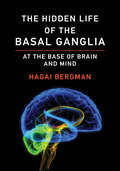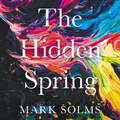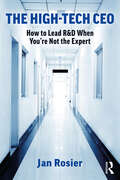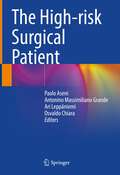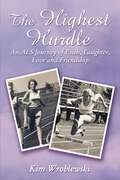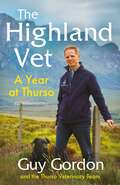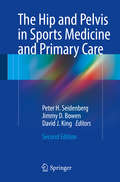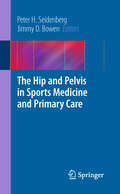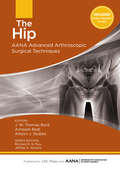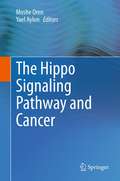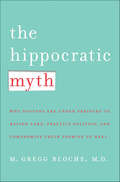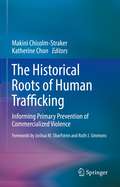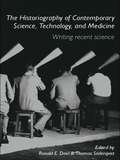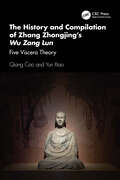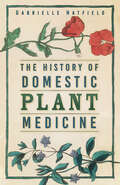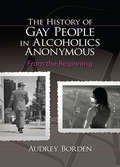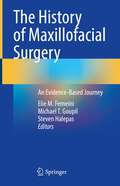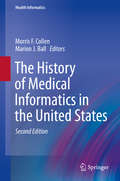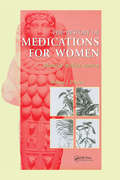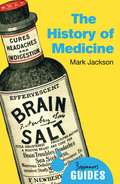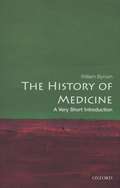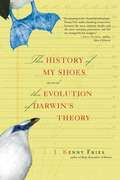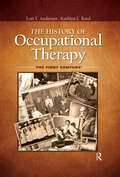- Table View
- List View
The Hidden Life of the Basal Ganglia: At the Base of Brain and Mind
by Hagai BergmanThe anatomy and physiology of the basal ganglia and their relation to brain and behavior, disorders and therapies, and philosophy of mind and moral values.The main task of the basal ganglia—a group of subcortical nuclei, located at the base of the brain—is to optimize and execute our automatic behavior. In this book, Hagai Bergman analyzes the anatomy and physiology of the basal ganglia, discussing their relation to brain and behavior, to disorders and therapies, and even to moral values. Drawing on his forty years of studying the basal ganglia, Bergman presents new information on physiology and computational models, Parkinson&’s disease and other ganglia-related disorders, and such therapies as deep brain stimulation. Focusing on studies of nonhuman primates and human basal ganglia and relying on system physiology and in vivo extra-cellular recording techniques, Bergman first describes the major brain structures that constitute the basal ganglia, the morphology of their cellular elements, their synaptic connectivity and their physiological function in health and disease. He discusses the computational physiology of the healthy basal ganglia, describing four generations of computational models, and then traces the computational physiology of basal ganglia–related disorders and their treatments, including Parkinson&’s disease and its pharmacological and surgical therapies. Finally, Bergman considers the implications of these findings for such moral concerns as free will. Explaining this leap into domains rarely explored in neuroscientific accounts, Bergman writes that the longer he studies the basal ganglia, the more he is convinced that they are truly the base of both brain and mind.
The Hidden Mechanics of Exercise
by Christopher M. GillenAs anyone who takes up a new sport quickly discovers, even basic athletic moves require high levels of coordination and control. Whether dribbling a basketball or hitting a backhand, limbs must be synchronized and bodies balanced, all with precise timing. But no matter how diligently we watch the pros or practice ourselves, the body's inner workings remain invisible. The Hidden Mechanics of Exercise reveals the microworld of the human body in motion, from the motor proteins that produce force, to the signaling molecules that activate muscles, to the enzymes that extract energy from nutrients. Christopher Gillen describes how biomolecules such as myosin, collagen, hemoglobin, and creatine kinase power our athletic movements. During exercise, these molecules dynamically morph into different shapes, causing muscles, tendons, blood, and other tissues to perform their vital functions. Gillen explores a wide array of topics, from how genetic testing may soon help athletes train more effectively, to how physiological differences between women and men influence nutrition. The Hidden Mechanics of Exercise tackles questions athletes routinely ask. What should we ingest before and during a race? How does a hard workout trigger changes in our muscles? Why does exercise make us feel good? Athletes need not become biologists to race in a triathlon or carve turns on a snowboard. But Gillen, who has run ten ultramarathons, points out that athletes wishing to improve their performance will profit from a deeper understanding of the body's molecular mechanisms.
The Hidden Spring: A Journey to the Source of Consciousness
by Mark SolmsWhy does it feel like something to be alive? For one of the boldest thinkers in neuroscience, solving this puzzle has been a lifetime's quest. Now at last, Mark Solms, who discovered the brain mechanism for dreaming, has arrived at his answer. More than just a philosophical argument, the Free Energy theory will profoundly change how you understand your own existence.The very idea that a breakthrough is possible may seem outrageous. Isn't consciousness intangible, beyond the reach of empirical methods? Yet Solms shows in forensic detail how misguided assumptions have concealed its nature. Only by sticking closely to the medical facts does a way past our obstacles appear. Join him on an extraordinary voyage into the strange realms beyond, and learn what we really are.
The High-Tech CEO: How to Lead R&D When You're Not the Expert
by Jan RosierThis book examines the impact of CEOs on firm performance and focuses on their role in science-based innovation to answer the question, is it possible to lead highly complex R&D projects and innovation that you do not understand? Today, science and technology move so fast that even managers of R&D teams can become quickly disconnected from new developments. Similarly, business leaders may be required to lead organisations with technical knowledge beyond their own expertise. How to manage teams and retain respect and influence is a recognised challenge. Filled with insight from managers and CEOs in science and technology organisations, the book unlocks the skills required to balance the leadership and managerial needs of the organisation, motivate the technical teams and drive successful innovation in new product development environments. Due to the vital role played by experts in a chosen field of technical and scientific expertise, the book also describes what these specialists need and expect from their leaders. The book is required reading for managers in high tech and scientific environments – the CEO, CSO and the R&D manager. It can also be used as a classroom reference book on the management skills required for leading high-tech projects.
The High-risk Surgical Patient
by Ari Leppäniemi Paolo Aseni Osvaldo Chiara Antonino Massimiliano GrandeIt is well known that certain diseases and patient conditions are associated with increased perioperative risk. The aim of this book is to define and identify the clinical factors that warrant a broader and more detailed assessment of pre-operative surgical risk in difficult and unusual clinical settings. One of the sections is dedicated to the main pathway of peri- and post-surgical critical care based on the patient-specific deterioration risk and associated diseases; here, a panel of selected experts describes the correct patient-oriented pathways for complex or unscheduled surgical operations in order to reduce the operative risk. In addition, the book describes the latest trends in minimally invasive surgical techniques that are associated with peri- and post-operative risk reduction, and provides an overview of recent advances in surgical simulation, focusing on perspectives in surgical research to increase patient safety.Guidance is also provided on extracorporeal membrane oxygenation (ECMO), Left Ventricular Assist Devices (LVADs), and their management in patients requiring emergency surgery. The book will help surgical trainees recognize cases with the highest surgical risk and identify the most common complications at an early stage.
The Highest Hurdle: An ALS Journey of Faith, Laughter, Love and Friendship
by Kim WroblewskiIt was year of the Ice Bucket Challenge when MaryFran Peterlin-Kolp was diagnosed with Amyotrophic Lateral Sclerosis. A top college athlete and having earned a Ph. D in Exercise Physiology she was never afraid to rise up to a challenge and she decided that she would do "whatever it takes" to try to find a cure. MaryFran always had a strong Catholic Faith to rely on, great family support and would soon see how a small Northern Michigan town would rally around her. She would explore not just conventional western medicine but alternative treatments and therapies, diets, and of course rely on her faith to guide her. Using her positive attitude she takes us on her ALS journey with the belief that God chose her so that others could be spared with the hope that maybe she could help find a cure. You will laugh, cry and be amazed at how one woman could have such a lasting impact on a community and how that community helped to care for her. MaryFan will show you that all you need is faith, family, and some "Frantabulous Friends" to live a happy life.
The Highland Vet: A Year at Thurso
by Guy Gordon The Thurso Veterinary TeamDiscover the charms and challenges of working at Scotland's most northerly mainland veterinary practice.From performing farm animal caesarean sections at all hours to missing special occasions in order to treat much loved family pets in crisis, no two days in the work of vet Guy Gordon and his team are ever the same.Based in Thurso, northern Scotland, the small group of vets and their supporting staff cover a vast area of more than one thousand square miles. The expansive, wild and rural landscape in which they operate brings a huge variety of work depending on the season, with the delivery of newborn lambs and calves in the spring, and the arrival of seal pups to the northern Scottish coast starting in the autumn months.The Highland Vet shows what working in one of Britain's most beautiful and remote locations really involves. Inside, Guy and his team share the highs and lows, ups and downs and ins and outs of their daily work throughout the course of a year, making this a truly magical celebration of Scotland's northern Highlands, as well as the animals and people who call the region home.
The Hip and Pelvis in Sports Medicine and Primary Care
by Jimmy D. Bowen Peter H. Seidenberg Faafp Facsm Rmsk Faapmr Caqsm Cscs David J. KingNow in a revised and updated second edition, this practical guide remains an invaluable resource for improving the management of hip and pelvis injuries and presents a spectrum of treatment options for children, adolescents, adults and special populations. Opening with valuable clinical pearls for each topic, differential diagnosis is emphasized throughout the chapters, and evidence-based guidelines and sport-specific considerations aid the reader with injury evaluation and care. From fundamentals--including epidemiology, history and physical examination, imaging and gait assessment--to functional therapeutic interventions, injection techniques, taping and bracing, and both surgical and non-surgical interventions, The Hip and Pelvis in Sports Medicine and Primary Care, Second Edition is ideal for sports medicine physicians, primary care physicians, physical therapists and athletic trainers alike.
The Hip and Pelvis in Sports Medicine and Primary Care
by Jimmy D. Bowen Peter SeidenbergThis handbook is an invaluable resource for improving the management of hip and pelvis injuries in sports medicine and primary care. Chapters cover the fundamentals, including epidemiology, history and physical examination, and functional and kinetic chain evaluation. Injuries to children, adolescents, adults, and geriatrics are addressed. Differential diagnosis is emphasized, and evidence-based guidelines and sports-specific considerations aid the reader with injury evaluation and care. Notably, the book highlights the importance of understanding core stability when determining the source of pain. Gait assessment and imaging are featured as well. In addition, the text presents the spectrum of treatment options for hip and pelvis injuries and hip osteoarthritis. Functional therapeutic interventions, osteopathic manipulation, taping and bracing, and injection techniques are discussed. Indications for surgical interventions are also outlined. The book is complete with appendices that explain the evidence-based approach used throughout and the science behind physical therapy modalities. With its convenient format, this handbook is sure to receive lots of use from sports medicine physicians, primary care physicians, physical therapists, and athletic trainers seeking a practical guide to diagnosing and treating hip and pelvis pain.
The Hip: AANA Advanced Arthroscopic Surgical Techniques (AANA Advanced Arthroscopic Techniques series)
by Asheesh Bedi J.W. Byrd Allston StubbsCo-published with the Arthroscopy Association of North America, The Hip: AANA Advanced Arthroscopic Surgical Techniques is a comprehensive technique-based book that presents the latest diagnostic and reconstructive techniques in arthroscopic surgery for the hip. The Hip: AANA Advanced Arthroscopic Surgical Techniques is authored by premier arthroscopic surgeons Drs. J.W. Thomas Byrd, Asheesh Bedi, and Allston J. Stubbs and their international list of expert contributors. This comprehensive resource includes preferred physical examination testing and diagnostic imaging choices in pre-operative planning and patient selection, state-of-the-art step-by-step description of the procedures, detailed surgical equipment lists to perform each procedure, clear and precise indications for surgery and the thoughtful rationale behind stated contraindications, controversial indications, post-operative protocols, and potential complications. The written text is supported by numerous color images and a website with invaluable, narrated video clips depicting disease specific arthroscopic techniques specific to the hip. Features inside The Hip: AANA Advanced Arthroscopic Surgical Techniques Narrated video accompanies all surgical techniques, focusing on the stepwise approach to each operation Consistent organization throughout the book results in a bulleted and user-friendly interface for a quick reference or prolonged study Top 5 Technical Pearls for each procedure to enhance outcomes and to avoid common pitfalls and complications High-quality artwork and figures to complement clinical images Equipment and surgical technique checklists for quick reference prior to surgery Each expert contributor was chosen for his or her expertise for a specific topic related to The Hip, so the reader benefits by the highest quality and treatment recommendations to provide state-of-the-art care to his or her patient.Some chapter topics include: The Supine Approach to Hip Arthroscopy Use of Fluoroscopy in Hip Arthroscopy: A Correlation with Three-Dimensional Anatomy Treatment of the Iliopsoas Tendon: Indications and Arthroscopic Approaches for Lengthening and Release Special Considerations for Revision Hip Arthroscopy Management of the Deficient Labrum: Arthroscopic Labral Reconstruction - Indications and Technique
The Hippo Signaling Pathway and Cancer
by Moshe Oren Yael AylonThe Hippo signaling pathway is rapidly gaining recognition as an important player in organ size control and tumorigenesis, and many leading scientists are showing increased interest in this growing field and it's relation to cancer. For instance, for the past two years, over 60 researchers from all over the world, have gathered annually for an intensive "Hippo Pathway Workshop" in Rome, Italy. This year, the workshop has been sponsored by Keystone Symposium and will be held in Monterey, California in Spring, 2013.This confirms the growing interest for the Hippo field within the international scientific community. The prospective list of the chapters covers virtually all aspects of tumor biology. This is because members of the Hippo Pathway have been associated with numerous well-established cell signaling pathways, just to name a few; Ras, Wnt, TGFbeta and p53. Moreover, Hippo signaling is not solely involved in regulating "classic" tumor characteristics such as cell proliferation, survival and growth, but is also diversely involved in cell-autonomous and non-cell-autonomous differentiation, migration and organ size control. The primary audience are researchers interested in basic science in the areas of tumor suppression, cell cycle and size regulation, development and differentiation.
The Hippocratic Myth: Why Doctors Are Under Pressure to Ration Care, Practice Politics, and Compromise Their Promise to Heal
by M. Gregg BlocheWhen we're ill, we trust in doctors to put our well-being first. But medicine's expanding capability and soaring costs are putting this promise at risk. Increasingly, society is calling upon physicians to limit care and to use their skills on behalf of health plan bureaucrats, public officials, national security, and courts of law. And doctors are answering this call. They're endangering patients, veiling moral choices behind the language of science and, at times, compromising our liberties. In The Hippocratic Myth, Dr. M. Gregg Bloche marshals his expertise in medicine and the law to expose how: *Doctors are pushed into acting both as caregivers and cost-cutters, compromising their fidelity to patients*Politics keeps doctors from giving war veterans the help they need*Insurers and hospital administrators pressure doctors to discontinue life-saving treatment, even when patients and family members object*Medicine has become a weapon in America's battles over abortion, child custody, criminal responsibility, and the rights of gays and lesbians*The war on terror has exploited clinical psychology to inflict harmChallenging, provocative, and insightful, The Hippocratic Myth breaks the code of silence and issues a powerful warning about the need for doctors to forge a new compact with patients and society.
The Historical Roots of Human Trafficking: Informing Primary Prevention of Commercialized Violence
by Makini Chisolm-Straker Katherine ChonA public health approach to human trafficking requires a nuanced understanding of its root causes. This textbook applies a historical lens to human trafficking from expert resources for the multidisciplinary public health learner and worker. The book challenges the anti-trafficking paradigm to meaningfully understand historical legacies of present-day root-causes of human trafficking. This textbook focuses on history’s utility in public health. It describes history to contextualize and explain present times, and provides public health lessons in trafficking prevention and intervention. Public health recognizes the importance of multiple systems to solve big problems, so the chapters illustrate how current anti-trafficking efforts in markets and public systems connect with historical policies and data in the United States. Topics explored include:Capitalism, Colonialism, and Imperialism: Roots for Present-Day Trafficking Invisibility, Forced Labor, and Domestic Work Addressing Modern Slavery in Global Supply Chains: The Role of Businesses Immigration, Precarity, and Human Trafficking: Histories and Legacies of Asian American Racial Exclusion in the United StatesSystemic and Structural Roots of Child Sex Trafficking: The Role of Gender, Race, and Sexual Orientation in Disproportionate VictimizationThe Complexities of Complex Trauma: An Historical and Contemporary Review of Healing in the Aftermath of Commercialized Violence Historical Context Matters: Health Research, Health Care, and Bodies of Color in the United States Understanding linkages between contemporary manifestations of human trafficking with their respective historical roots offers meaningful insights into the roles of public policies, institutions, cultural beliefs, and socioeconomic norms in commercialized violence. The textbook identifies sustainable solutions to prevent human trafficking and improve the health of the Nation.The Historical Roots of Human Trafficking is essential reading for students of public health, health sciences, criminology, and social sciences; public health professionals; academics; anti-trafficking advocates, policy-makers, taskforces, funders, and organizations; legislators; and governmental agencies and administrators.
The Historiography of Contemporary Science, Technology, and Medicine: Writing Recent Science (Routledge Studies in the History of Science, Technology and Medicine #Vol. 23)
by Ronald E. Doel Thomas SöderqvistAs historians of science increasingly turn to work on recent (post 1945) science, the historiographical and methodological problems associated with the history of contemporary science are debated with growing frequency and urgency. Bringing together authorities on the history, historiography and methodology of recent and contemporary science, this book reviews the problems facing historians of technology, contemporary science and medicine, and explores new ways forward. With contributions from key researchers in the field, the text covers topics that will be of ever increasing interest to historians of post-war science, including the difficulties of accessing and using secret archival material, the interactions between archivists, historians and scientists, and the politics of evidence and historical accounts.
The History and Compilation of Zhang Zhongjing’s Wu Zang Lun: Five Viscera Theory
by Yun Xiao Qiang CaoPeople who have studied acupuncture and Chinese medicine recognize Zhang Zhongjing as the author of two seminal texts that are among the most influential in Chinese medical history: the Treatise on Cold Damage Disorders (Shāng Hán Lùn, 伤寒论) and Essential Prescriptions from the Golden Cabinet (Jīn Guì Yào Lüè, 金匮要略). However, what is less well-known is that Zhang Zhongjing authored several other texts, all of which were lost over time, with the sole exception of the Five Viscera Theory (Wǔ Záng Lùn, 五藏论). This was discovered in 1900 in a hidden library of China’s Mogao Caves of Dunhuang by a Taoist priest named Wang Yuanlu.The History and Compilation of Zhang Zhongjing’s Wu Zang Lun stands as the first comprehensive work in English detailing the history and compilation of Zhongjing’s Five Viscera Theory (Wǔ Záng Lùn, 五藏论). It uses storytelling to illuminate the historical context of the eight versions of this book that were discovered: five versions found in Dunhuang and three versions from Zhejiang China, Korea, and Japan respectively. By exploring the origin and development of these versions, this book not only delves into Traditional Chinese Medicine but also intertwines fascinating elements of humanities, history, and geography. The reader is offered insight into the Dunhuang manuscripts’ background and the significance of Zhongjing’s contributions to medical literature.
The History of Domestic Plant Medicine: The History of Domestic Plant Medicine
by Gabrielle HatfieldThe debt medicine owes to botany is not commonly appreciated. In the past, medicine relied almost entirely on plants, and even today, many western medicines are plant derived. Despite this, historians have largely neglected the study of domestic medicine, practised by the ordinary person and passed down through generations, in favour of ‘official medicine’. The History of Domestic Plant Medicine brings together manuscripts, letters, diaries, personal oral interviews and other primary evidence to produce a detailed picture of the medicinal use of native plants in Britain from 1700 to the present day. Recording for posterity this neglected aspect of our heritage, it is a valuable contribution to the study of the folklore of modern Britain and a fascinating piece of social history.
The History of Gay People in Alcoholics Anonymous: From the Beginning
by Audrey BordenThe History of Gay People in Alcoholics Anonymous documents and honors the ways thousands of LGBT people have carried Alcoholics Anonymous' message. This illuminating chronicle includes interviews and documents that detail the compelling history, recovery, and wisdom of gay people in AA. The book examines the challenges AA faced as the fellowship endeavored to become a more inclusive and cohesive community. The first-person accounts narrate the important work of influential gay and straight AA members that led key events in AA’s history. The author includes material on the steps and traditions of AA, and on becoming an ally to LGBT people on the road to recovery.Topics in The History of Gay People in Alcoholics Anonymous include: the gay origins of AA’s Third Tradition a comparison of treatments for alcoholism and homosexuality compelling portraits of sober gay life in the 1950s and 1960s the debate in AA over meetings for gay alcoholics interviews with members and co-founders of the first gay AA meetings the history of the first gay AA/Al-Anon conference interviews with pioneering gay addiction professionals the history of AA pamphlet “AA and the Gay/Lesbian Alcoholic” Alcoholics Together, and why a parallel AA organization for gay alcoholics formed in southern California strategies AA’s gay members developed to make their meetings simultaneously safe and public—and why some of them are still necessary today much more The History of Gay People in Alcoholics Anonymous is an enlightening book for members of the LGBT and heterosexual recovering community, alcoholism and addiction professionals, as well as physicians, counselors, psychiatrists, psychologists, social workers, clergy, historians, sociologists, educators, students, and anyone interested in learning more about AA or this aspect of the community’s history.
The History of Maxillofacial Surgery: An Evidence-Based Journey
by Elie M. Ferneini Michael T. Goupil Steven HalepasThe multi-authored, multi-institutional, and multi-specialty-based text is designed as a valuable resource for surgeons working on the maxillofacial region. Meant to be a clinically based history of the past, the present, and the future of the field, this is a one-of-a-kind text that will cater to a variety of professions: from oral & maxillofacial surgeons, plastic and reconstructive surgeons, otolaryngologists – head and neck surgeons, cosmetic surgeons and the general dental practitioner. The History of Maxillofacial Surgery: An Evidence-Based Journey is divided into three sections for ease of understanding: The first section gives an overview of the early history; the second section provides a discussion of conventional procedures; and the third section gives a history of advanced procedures and techniques. By understanding the fundamental procedures and techniques of the field, practitioners can continue to further the field by building upon the past. Including historic case studies paired with real patient photos, this text details why professionals do what they do today with insight directly from the clinic. To provide a unique perspective the book is edited by three individuals at different stages of their careers. Each chapter is authored by a young surgeon paired with a seasoned surgeon.
The History of Medical Informatics in the United States
by Morris F. Collen Marion J. BallThis is a meticulously detailed chronological record of significant events in the history of medical informatics and their impact on direct patient care and clinical research, offering a representative sampling of published contributions to the field. The History of Medical Informatics in the United States has been restructured within this new edition, reflecting the transformation medical informatics has undergone in the years since 1990. The systems that were once exclusively institutionally driven - hospital, multihospital, and outpatient information systems - are today joined by systems that are driven by clinical subspecialties, nursing, pathology, clinical laboratory, pharmacy, imaging, and more. At the core is the person - not the clinician, not the institution - whose health all these systems are designed to serve. A group of world-renowned authors have joined forces with Dr Marion Ball to bring Dr Collen's incredible work to press. These recognized leaders in medical informatics, many of whom are recipients of the Morris F. Collen Award in Medical Informatics and were friends of or mentored by Dr Collen, carefully reviewed, editing and updating his draft chapters. This has resulted in the most thorough history of the subject imaginable, and also provides readers with a roadmap for the subject well into later in the century.
The History of Medications for Women: Materia Medica Woman
by M.J. O'DowdThe first work of its kind, The History of Medications for Women: Materia medica woman is a richly detailed, far-ranging illustrated history of medications for women in all the great cultures and civilizations, from ancient times to the present. Compiled by an acclaimed author of medical history literature, this is the only book that extends from the earliest uses of ergometrine, lettuce, and mummy medicine, through the history of women's medications in ancient Assyria and Egypt, and into the 16th through 20th centuries. With the main sections organized by origin and timeline, the book contains lists of medications used by women from earliest times to the present accompanied by historically-based text. The author includes botanical, chemical, pharmacalogical, and therapeutic details where appropriate, as well as extensive quotations from both contemporary and old, rare books. The text is complemented with the history of obstetrics and gynecology, along with short biographies and illustrations. Additionally, the author presents a unique fund of hard-to-find information in sections devoted to topics such as anesthesia and analgesia, antiseptics, antibiotics and chemotherapy, blood transfusion and Rhesus disease, eclampsia, family planning, menopause, and uterine stimulants. Interesting and thought-provoking, The History of Medications for Women will not only provide an enjoyable read, but will allow you to appreciate the past and look at the future with a new perspective.
The History of Medicine: A Beginner's Guide (Beginner's Guides)
by Mark JacksonIn a world burdened by chronic conditions and mutating viruses, with a health service strained to its limits, the history of medicine challenges our understanding of what it means to be healthy. By illuminating the ailments and methods of the past, our own dilemmas about medical practice and policy can be put into a new perspective. Esteemed historian Mark Jackson takes us from the dawn of medicine in the ancient world to the most recent developments pioneered in the 21st century's hospitals. On the way, Jackson explores Indian and Chinese traditions, as well as the origins of today's so-called alternative therapies, offering piercing insight into how medicine has reflected and shaped society throughout the ages.
The History of Medicine: A Very Short Introduction
by William BynumAgainst the backdrop of unprecedented concern for the future of health care, this Very Short Introduction surveys the history of medicine from classical times, through the scholastic medieval tradition and the Enlightenment to the present day. Taking a thematic rather than strictly chronological approach, W.F. Bynum, explores the key turning points in the history of Western medicine-such as the first surgical procedures, the advent of hospitals, the introduction of anesthesia, X-Rays, vaccinations, and many other innovations, as well as the rise of experimental medicine. The book also explores Western medicine's encounters with Chinese and Indian medicine, as well as nontraditional treatments such as homeopathy, chiropractic, and other alternative medicines. Covering a vast amount of information, this Very Short Introduction sheds new light on medicine's past, while at the same time engaging with contemporary issues, discoveries, and controversies, such as the spiraling costs of health care, lack of health insurance for millions, breakthrough treatments, and much more. For readers who wish to understand the how we have arrived at our current state of medical practice and knowledge, this book is essential reading.
The History of My Shoes and the Evolution of Darwin's Theory
by Kenny Fries<p>In The History of My Shoes, Kenny Fries narrates two stories: the development of the theory of "survival of the fittest," as articulated by Charles Darwin and Alfred Russel Wallace; and the history of his ever-changing, made-to-order, orthopedic shoes. <p>The famously important first story, as told by Kenny Fries, is a condensed and colorful account of the race between Darwin and Wallace to formulate their groundbreaking theories. <p>At the same time, Fries, a gay and disabled man, tells a deeply personal story of the evolving consciousness of his own "adaptations," represented by his shoes. As a child, Fries was abused by both his father and brother, and emerged into adulthood swaddled in ambiguities of self and memory. <p>These he has explored in his brutally frank memoir, Body, Remember. In this poetic, introspective book, Kenny Fries imaginatively illustrates how his identities intersect. He writes, "Much of my own work the past fifteen years has been concerned with the body, as both subject and metaphor; as the place where the personal becomes the universal; as the site of memory, language, and desire." <P>Although only the "fittest" may survive, Fries learns that adaptation and variation are critical to survival. What is deemed normal, or even perfect, are passing phases of the ever-changing embodiment of nature in our world. In the end, Darwin and Wallace's discoveries resonate with Fries's own story in The History of My Shoes.
The History of Occupational Therapy: The First Century
by Kathlyn Reed Lori AndersenTo understand who we are and where we are going,we first need to understand who we were and where we came from.The History of Occupational Therapy: The First Century by Drs. Lori T. Andersen and Kathlyn L. Reed follows a chronological timeline, providing discussions and reflections on the influence of various personalities, politics, legislation and policy, economics, socio-cultural values, technology, and educational factors that led to the progressive maturation of the profession.The History of Occupational Therapy: The First Century includes photographs of pioneers, leaders, and advocates of occupational therapy; pictures of occupational therapy artifacts, including newspaper clippings and historical documents; maps showing historical locations in occupational therapy practice and education; and sidebars that give glimpses into personalities and events.Features: The only historical book on the profession’s first 100 years Scholarly book for teaching, professional, and personal use Included with the text are online supplemental materials for faculty use in the classroom. Features glimpses into occupational therapy personalities The History of Occupational Therapy: The First Century provides all occupational therapy practitioners and occupational therapy students with a historical context of the profession. Generous use of photographs and illustrations create a visually stimulating and scholarly book that provides the historical context of the profession, from the formative stages in the 18th century to the eve of the Centennial Celebration in 2017, as well as a glimpse into the future.“History can tell us that the seeming hardship, the self-doubts of efficacy, the searching for our roots are actually precursors for establishing a new strategic vision and plan that could put us in the forefront of progress.”Robert Bing, President, American Occupational Therapy Association, 1983
The History of Problem Gambling
by Nigel E. Turner Peter FerentzyThis book documents the history of ideas about problem gambling and its link to addictive disorders. The book uses a combination of literature review and conceptual and linguistic analysis to explore the way ideas about problem gambling gave changed over time. It examines the religious, socio-cultural, and medical influences on the development of the concept of problem gambling as a disease, along with the ways in which such ideas were influenced by attitudes about substance abuse. The history of mental illness, notably as it pertains to themes such as loss of control over behavior, is also addressed. The book ends with a discussion of the current status and future prospects, with an eye to which ideas about problem gambling and addictions seem most promising and which should perhaps be left behind.
